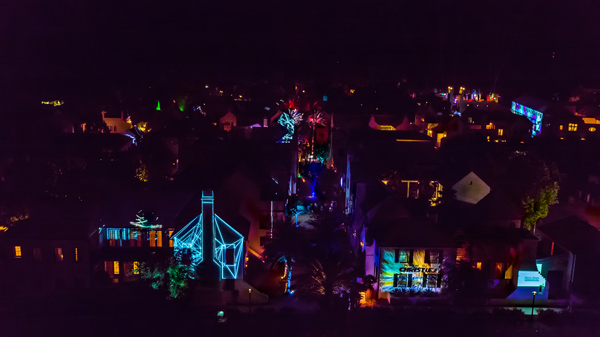Alys Beach is a 158-acre community along the shores of the Gulf of Mexico, on Florida’s panhandle coast. Each of the 107 chalk-white homes and condos evoke Bermuda, Antigua, Guatemala. Residents can choose from a book of approved architects. The streets are silent. Grass is manicured with golf-course precision. Access to the ocean, and its white-sugar sand, is by an Alys Beach© key-card. One of the few places-of-business is an Alys Beach logo store. The million-dollar homes (many people’s second or third) are pressure washed at least once a year to maintain their pristine pallor.
It’s an ideal spot for a digital graffiti festival.
Eight p.m., late May. Residents, tourists and visitors from the neighboring towns of Seaside and Rosemary Beach are lined up beside Highway 30A for the sold-out festival. Entrances in and out of town are blocked by security guards in Alys Beach© polos. Tickets checked, festivalgoers are admitted onto Sea Garden Walk, which winds between the connected residences. Meandering along the shell-encrusted path, eyes are drawn to one of the house’s belfries; there, under a soft bulb, a giant moth beats its wings. This isn’t a native species—it’s Nightfall (2017) by Helen Marshall. The UK-based artist scanned a sun-bleached toy moth and animated it into being. Then Brett Phares, the festival’s curator, projected it onto Alys Beach.

Nightfall by Helen Marshall (photo credit Jacqueline Ward)
“Social cinema.” “Expanded Cinema.” “Techorating.” Phares used all these phrases in an attempt to describe the flickering images, and associated soundtracks, scattered throughout the town for the 10th Annual Graffiti Festival. An artist himself, with a flair for theory, Phares acknowledged the inherent semantic conundrum: graffiti is an act of defiance, placing something on a wall that should not be there. But this wasn’t “photon bombing,” these pieces were condoned and co-sponsored by Alys Beach with the residents giving their blessings to the projections twinkling outside—and on—their windows.
But none of the other terms that could be ascribed to these works—video art, digital projections—seem any better. Perhaps the best label would be “Site-Specific Digital Art Projections,” though that doesn’t have quite the same Instagramability as #dgalysbeach. (It’s perhaps telling that Best In Show went to Liquid Love by Kameron Neal, which featured the Brooklyn-based artist in front of various graffitied New York walls.) Further, while some of the installations could be classified as “video art,” some, such as Artist-in-Residence Robert Seidel’s Tempest, defy even that categorization.

Alys Beach Digital Graffiti Fest from above Sea Garden Walk (photo credit Jacqueline Ward)
Along the northern edge of town shimmers Lake Marilyn—its curvature reminded the planner of the actress. Spanning it is a bridge, within it are fountains, around it are residences. Seidel installed a smoke machine, then projected on the fog, spouts and homes a montage of abstract videos and images, all accompanied by an equally translucent soundtrack. And the visual storm didn’t end there. North of Somerset Bridge rise the cypress trees and grasses of the Alys Beach nature preserve; with another projector placed on the bridge, Seidel transformed the darkened trees into an Impressionist acid trip.
Back in the center of town, attendees were entering another hallucination with German artist Holger Förterer’s fluidium 2: visitors’ shadows manipulated the projected spectacle as though it were a vertical oil spill. (“Try moonwalking,” Forterer advises.)
Interaction with the art is what separates—or maybe defines—this digital work in relation to its video art cousins. Film theorists had long deconstructed the ritual of watching a film as a passive and dreamlike experience: sitting immobile in the dark and “taking in” the images on screen; identification was not with self, but with the projector or main character.Now, movies are screened across media and locations, often in a bright room, often with the viewer simultaneously checking another screen. Digital Graffiti seems in the realm of the zeitgeist: your shadow often joins the projected work, or even, in the case of fluidium 2, influences it.
“You become part of the scene,” Phares said. “You confirm your identity.”
The Festival also speaks to the blurring of art, architecture and technology with a piece defined by strict lines: Artist-In-Residence Krystal Schultheiss’ Reflections. The Australian filmmaker—who enjoys “video jockeying at music fests”—used complex architectural and design software to map one of the houses off 30A. (Schultheiss wisely chose to incorporate this mapping into the piece, transforming architectural process into art).

“Fluidum-2,”-Holger-Foerterer,-a-Special-Recognition 2017 honoree (photo credit Digital Graffiti Festival)
Drivers heading east on the highway watch as a white line draws itself up the building’s corner, and around its windows, defining the space. Then a decidedly non-digital event unfolds: crystals, following a digitized version of their molecular structure, grow in their demarcated area, expanding across the wall. (This piece, and those of the other Artists-in-Residence, were projected by one of the Fest’s sponsors, Christie, which provided state-of-the-art, $100K, put-into-place-by-forklift projectors.)
Whatever it all is, or means, or costs, it’s beautiful. The walls of Alys Beach are whiter-than-white, and if trash exists in the town, or even among its residents, it’s nowhere to be seen. (Not surprisingly, the film The Truman Show was shot in a nearby town.) To combat the relentless Gulf sun, architects have covered the walls with a reflective paint, essentially making each house and condominium a movie screen. Combine this with a lack of light and sound pollution, and Alys Beach becomes an ideal movie palace. Don’t try to understand the town, or the theory, just enjoy the dazzling colors.
Oh, and don’t try any actual graffiti.
“It would be removed within an hour,” an Alys Beach rep pointedly said. “And the culprits would be found.”


